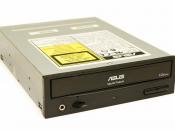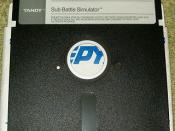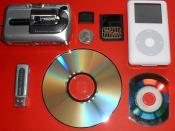Having an understanding of computer systems can help with understanding and accommodating the needs of an organization as well as personal computer needs. The purpose of this informative paper is to explain methods of information input and output, what situations are appropriate for various devices and explain to the role of various items in determining the speed of a computer.
Methods of Data InputPrinted questionnairesPrinted questionnaires are used for gathering and capturing raw data. All raw data such as man hours for employee payroll checks, university grading systems and so forth must be keyed into a computer programs and properly calculated to pay employees and give students their proper grades. The computer keyboard is the best input device for printed questionnaires.
Telephone surveyTelephone surveys are used for gathering and collecting information over the phone verbally. Voice activated input devices are the best route for inputting verbal responses. This type of device would save time and money for an organization because responses can be voice activated and computer recognizable which would cut out the need for human input thus saving on human resources (man hours).
Bank checksBank checks, having multiple numbers and a multitude of information are time consuming at best and costly on human resources with a high record of error. The Magnetic Ink Charter Recognition (MICR) would be the best input device for this process. The MICR can read all the numbers at the bottom of the check in seconds without human error which would save time, money and human errors.
Retail tagsRetail tags are used for pricing goods for sale. The bar code scanner would be the best input device since it can read numbers quickly and more accurately than humans can. The bar code scanner would save a company time, money, human resources and human error.
Long documentsLog documents are manually written and input into computer systems. Scanners with optical scanning recognition (OCR) are the best input device for such information. This type of device can scan any document and transfer it to the computer in seconds versus hours of manual labor. Therefore, scanners with OCR capabilities can save a company in labor costs and time as well as cut down on human error.
Methods of Data OutputHand Held ComputerHand held computers consist of anything hand or pocket size from a cell phone to a PDA or even a lap top PC. Many of the older hand held devices used an external display unit i.e. computer pen or such devices. An on-board display or touch screen would be the best output device for hand held computers because they alleviate the need for an external device which could become lost or misplaced easily.
Color PhotographColor photographs are color photographs, or so one might think. While most printers can scan and copy photos nicely with quality paper there is a difference in photograph brightness and crispness depending on the type of printer used. Color inkjet or laser jet printers are the best output devices because they produce the best color images.
ResumeWhile many individuals still use copy companies such as KINKO's for printing resumes, inkjet or laser jet printers are the best output devices because they produce the best images quickly and for pennies on the dollar.
Memorandums, Statistical Reports, and Annual ReportsWhile many companies still use older printers or printing companies for printing memorandums, statistical reports and company annual reports, inkjet or laser jet printers are the best output devices because they produce the best images quickly and for pennies on the dollar.
Situations Appropriate for Different Types of DevicesHard diskHard disks give users direct access to stored data which reduces access time. Hard disks are the best data storage device choice for individuals or businesses in need of large data storage devices.
Floppy diskFloppy disks are portable data storage devices in the form of a thin flexible casing. Floppy discs are good for small files that can be transported from work to home for completion.
RAMRAM is a computer memory device. Most RAM is upgradable depending on a computer's upgradable storage space. While RAM is not typically used for data storage, it does have the capacity to store and retrieve data at speeds that exceeds four to five times faster than a really fast hard drive. RAM works well for viewing internet pages for research. The higher the ram the more pages one can open at one time.
CD ROM, Tape and Flash or Jump DriveCD ROM's, Data Tape Cartridges and Flash or Jump Drive's are all portable storage devices for storing information. Each has its strengths and weaknesses but all are good for transferring, backing up and sharing information from computer to computer with ease. These portable devices are highly reliable over hard drives because there are no moving parts that can become broken in transport.
Items Used in Determining the Speed of a ComputerRAMThe more RAM a computer has the more data a PC can hold. That said, one might think that the more RAM there is the faster a PC will be. However, while users may perceive more speed when RAM is boosted, RAM does not actually affect the speed of the computer itself.
Clock speedClock speed is just like the name suggests. The rate of speed the clock is set to determines the speed of the computer. According to Stair, R. and Reynolds, G., (2006) "Each CPU produces a series of electronic pulses at a predetermined rate, called the clock speed, which affects machine cycle time."Data on Hard Disk, Data on CD ROM and Data on Floppy DiskHard Disk, CD ROM and Floppy Disk data storage devices are used for storing and retrieving and viewing various types of data. While Hard Discs, CD ROM's and Floppy Disks do not actually affect the speed of a computer in any way, users' perception may be that the computer is faster while the storage device is in use though.
ReferenceStair, R. and Reynolds, G. (2006). Information Systems: Fundamentals of Information Systems (3rd ed.). Course Technology.



Great
great summary.. very informational
0 out of 0 people found this comment useful.